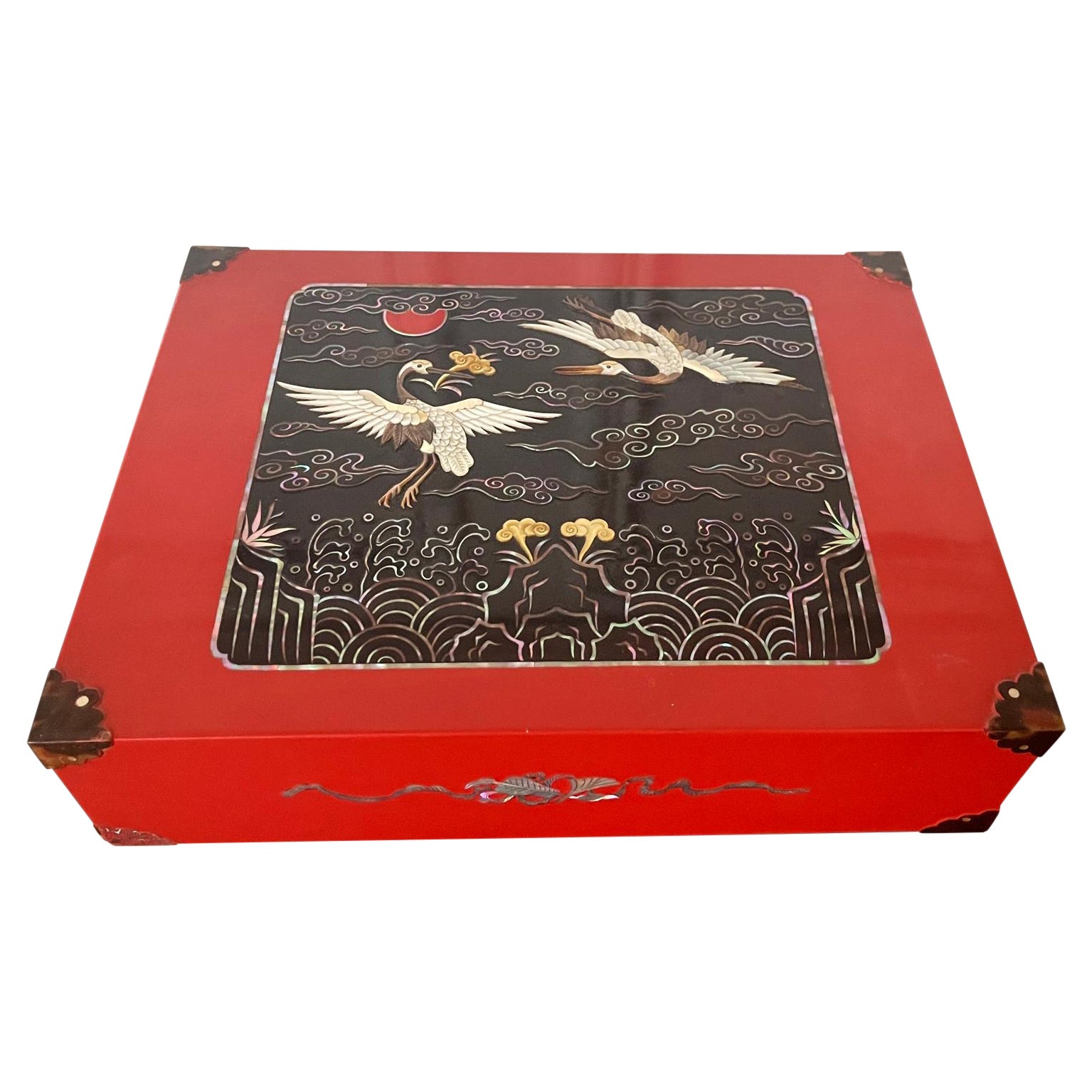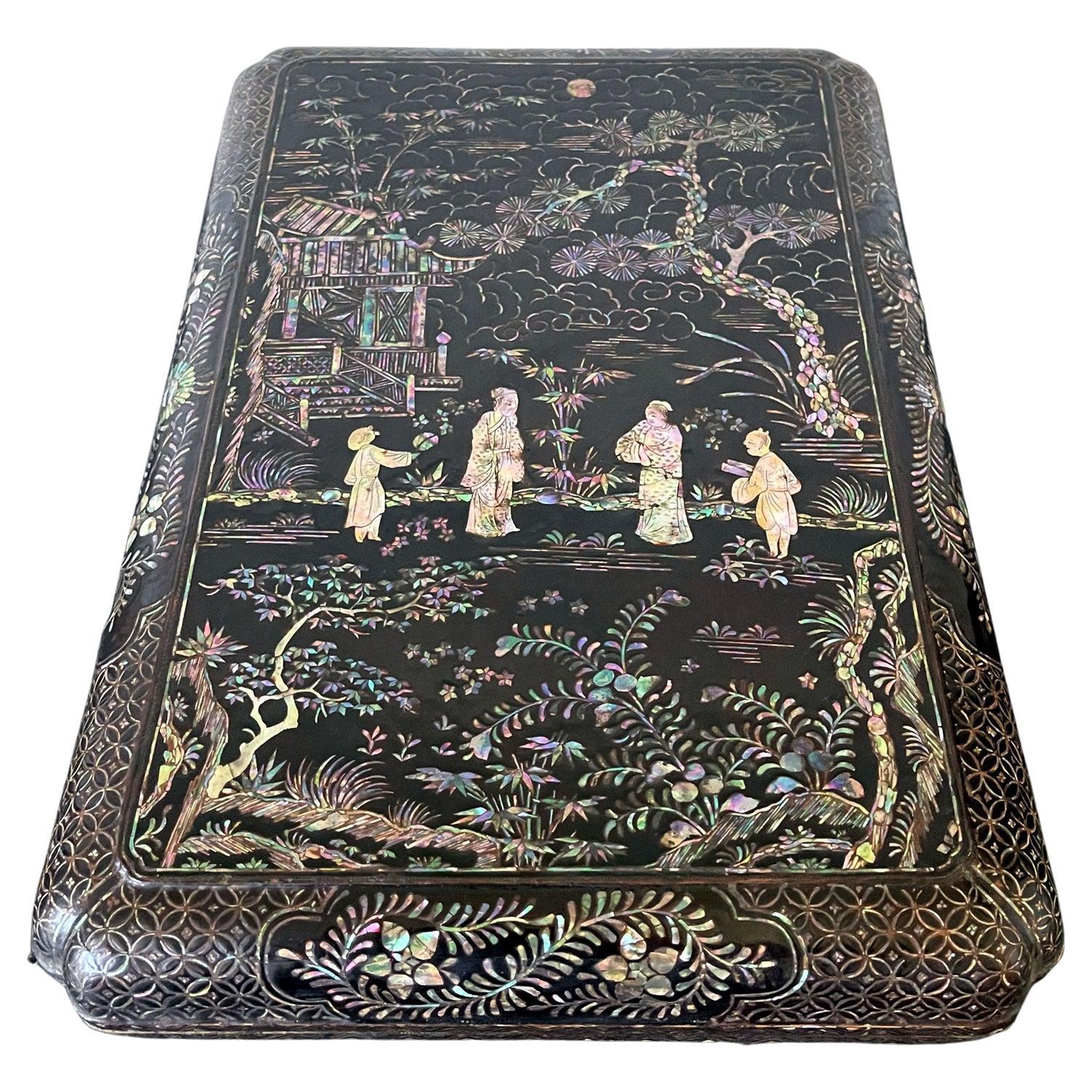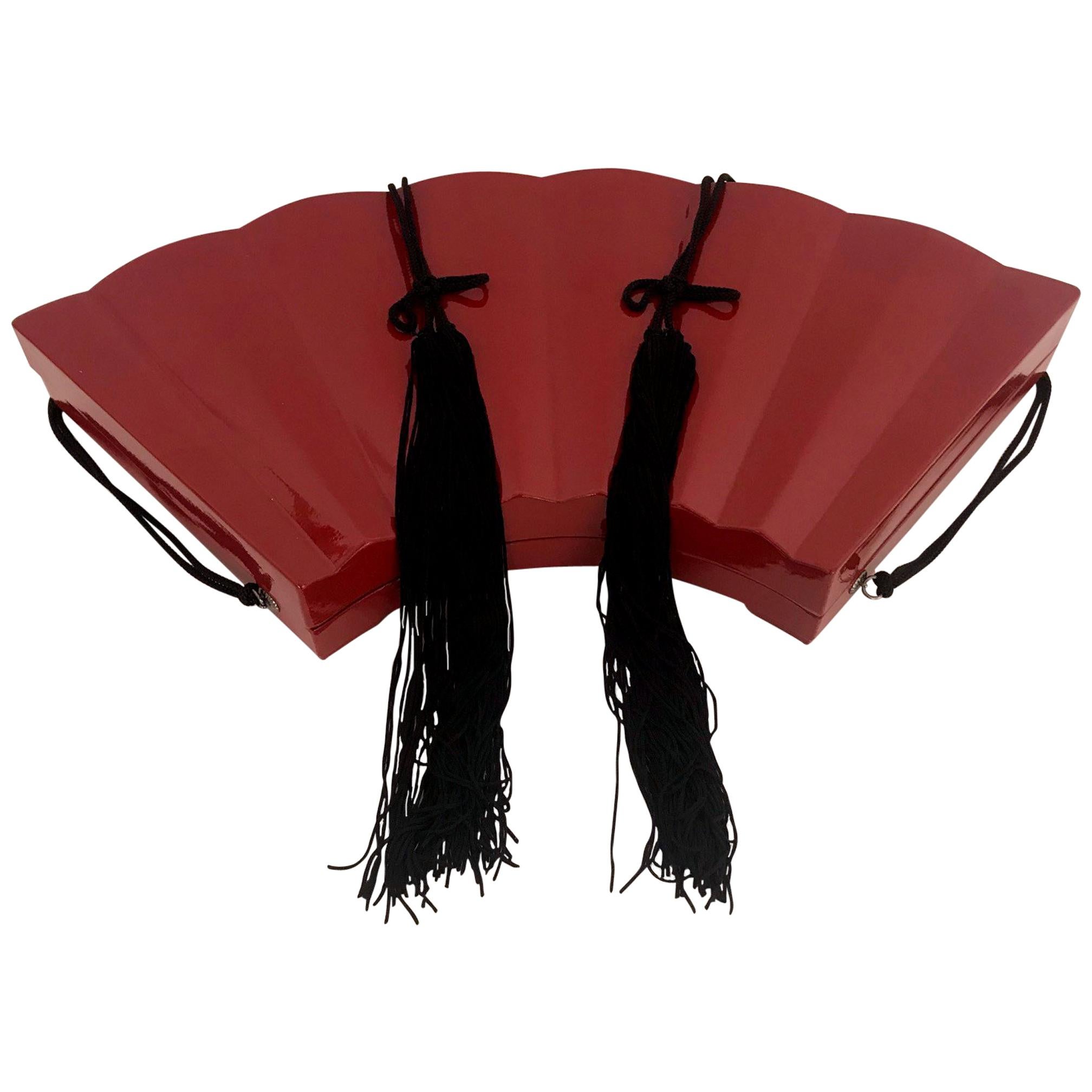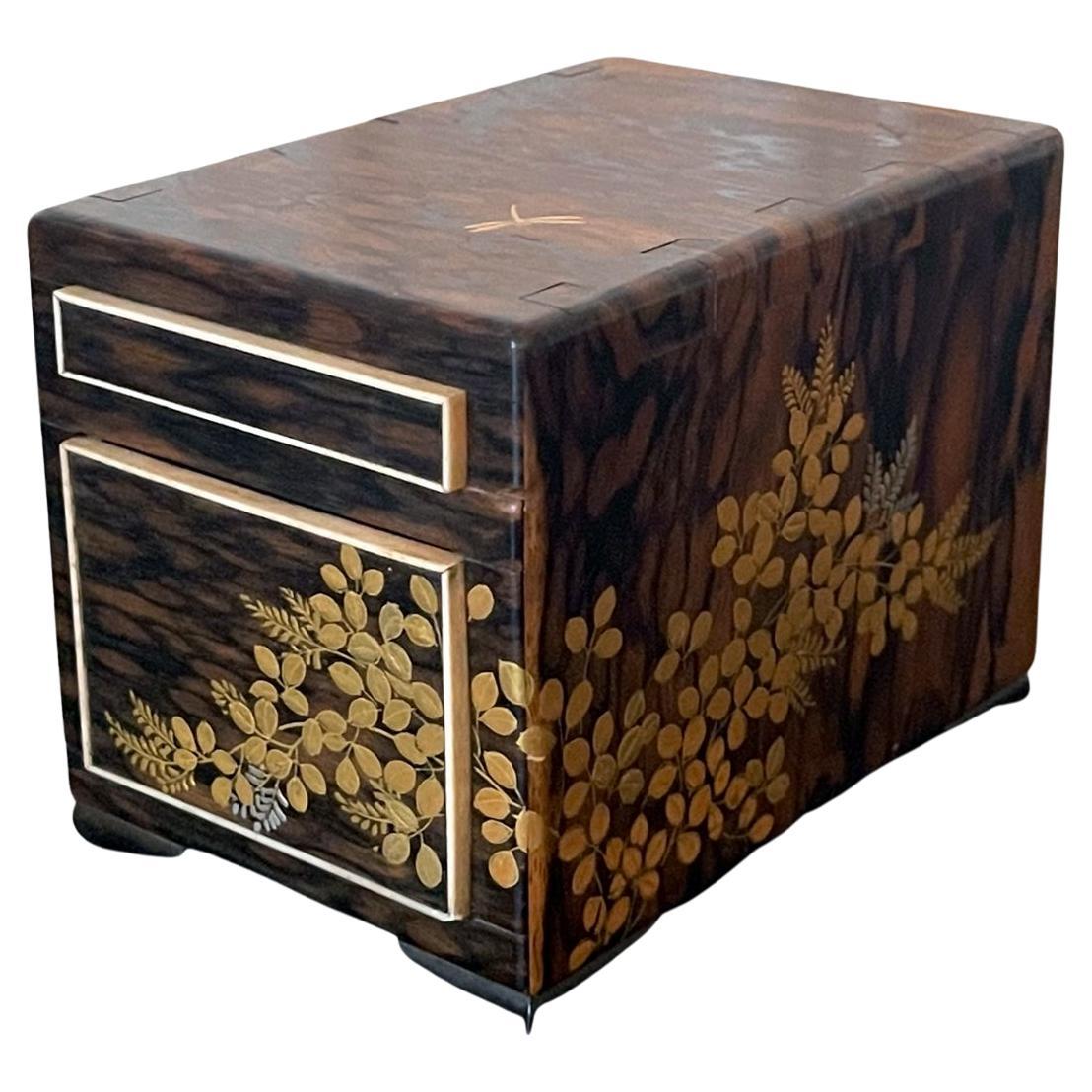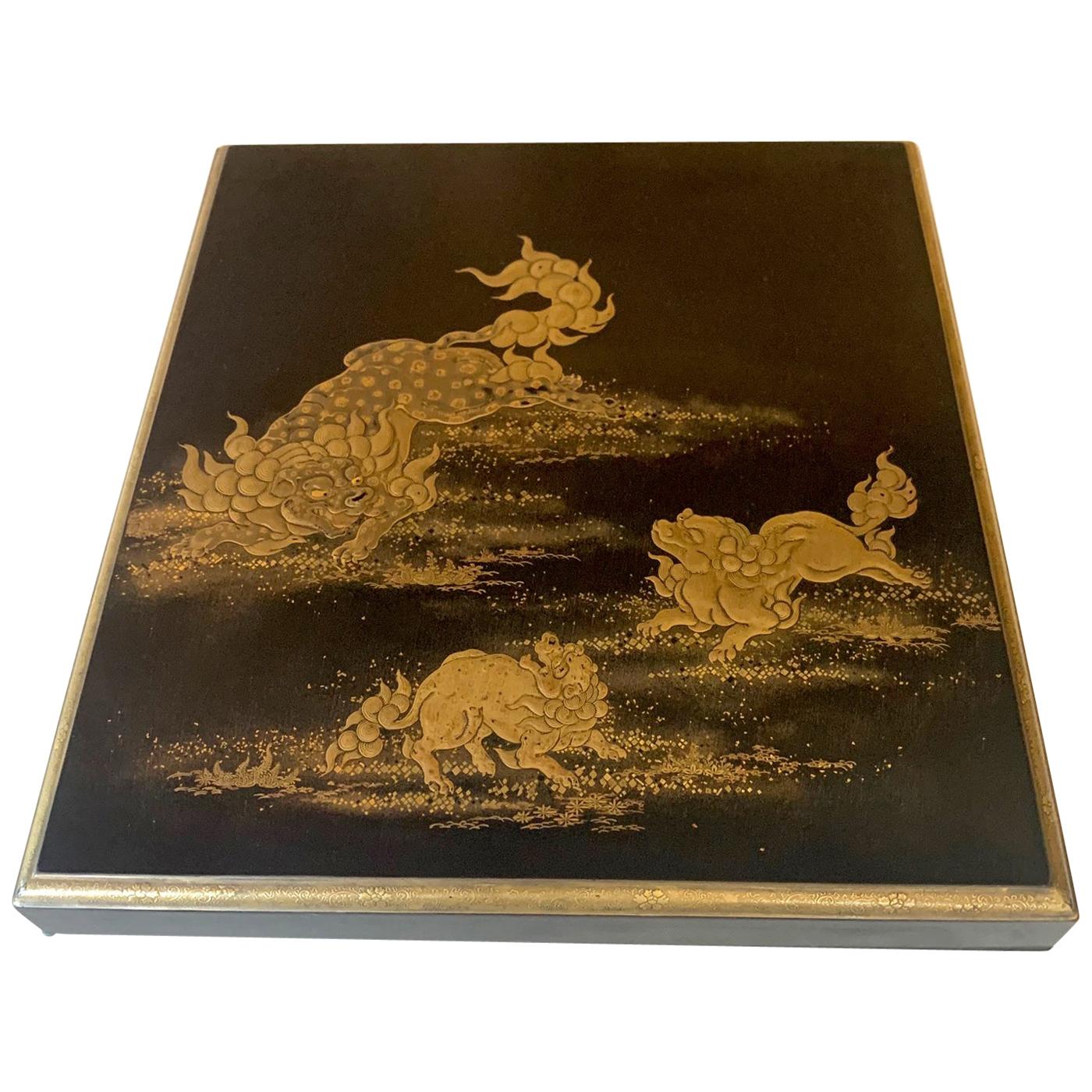Items Similar to Unusual Japanese Lacquer Inkstone Box with MOP Inlays
Want more images or videos?
Request additional images or videos from the seller
1 of 17
Unusual Japanese Lacquer Inkstone Box with MOP Inlays
About the Item
A Japanese black lacquer box with mother of pearl inlays circa early 20th century, end of Meiji period. It was likely to be used to store inkstone or other scholarly items. The piece displays several interesting characteristics that appear puzzling initially. First, the form is not typical Japanese, but more Chinese and Korean, with its scalloped base. Second, the decoration of MOP inlays also suggests a Korean and Chinese affiliation, especially with the linear borders and the scrolling cloud patters on the sides of the box. These two observations suggest that the box may be from Ryukyu Island instead of Japanese mainland. Third, strikingly in the center of the cover, a bold quarterly floral pattern outlined with MOP was filled with a striking mottled red lacquer using tsugaru nuri technique. Tsugaru nuri was a pure Japanese invention from Aomori prefecture, centralized in Hirosaki city, dated to Edo period. Fourth, the particularity of the decoration using four dancing foxes (kitsunes) also indicates a Japanese origin. Kitsunes spirits permeate in a wide contexts in Japanese folklores and they could represent both the good and the tricky natures of the animal. More importantly, kitsunes were often used as motifs in Japanese decorative art, from painting, prints to lacquer ware (while it is less common to see them in Chinese and Korean art). These seemingly contradicting features point to a likelihood that the piece was made by an artist who created his unique style by combining the Ryukyu Island aesthetic with tsugaru nuri from Northern Japan and kitsunes motifs that were popular in Japanese art.
- Dimensions:Height: 3.4 in (8.64 cm)Width: 10 in (25.4 cm)Depth: 11.5 in (29.21 cm)
- Style:Japonisme (Of the Period)
- Materials and Techniques:
- Place of Origin:
- Period:
- Date of Manufacture:Early 20th Century
- Condition:Wear consistent with age and use. Minor losses. Stable age cracks on the corners, small dings and bumps along the edges, contact wear on the base. Because of the color, none is conspicuous to compromise the beauty of this piece. All as shown.
- Seller Location:Atlanta, GA
- Reference Number:1stDibs: LU945022333322
About the Seller
5.0
Platinum Seller
These expertly vetted sellers are 1stDibs' most experienced sellers and are rated highest by our customers.
Established in 2006
1stDibs seller since 2010
479 sales on 1stDibs
Typical response time: <1 hour
- ShippingRetrieving quote...Ships From: Atlanta, GA
- Return PolicyA return for this item may be initiated within 2 days of delivery.
More From This SellerView All
- Vintage Korean Lacquer Box with Inner Tray and MOP inlaysLocated in Atlanta, GAA lovely vintage Korean lacquer box in bright red and decorated with mother-of-pearl inlays circa 1970-80s. The square form box features an auspicio...Category
Late 20th Century Korean Arts and Crafts Lacquer
MaterialsMother-of-Pearl, Lacquer
- Antique Japanese Lacquer and Inlay Box from Ryukyu IslandLocated in Atlanta, GAA lacquer presentation box with mother-of-pearl inlays from Japanese Ryukyu Islands circa 17-18th century. The lidded box in rectangular form with rounded corner is a classic example...Category
Antique 18th Century Japanese Japonisme Lacquer
MaterialsMother-of-Pearl, Lacquer
- Fine Japanese Lacquered Inro with Inlays by KajikawaLocated in Atlanta, GAA Japanese four-case lacquer inro by a member of Kajikawa family circa 19th century (late Edo to early Meiji period). It depicts a nocturnal scenery of a meandering stream surrounded by bush clovers, where a full moon is reflected on the water. It was masterfully decorated in gold and silver maki-e using a combination of techniques including takamakie, togidashi and kirigane as well as aogai (abalone shell) inlays. The stream was set between the slightly elevated banks, adding to this piece a already strong three-dimensional composition. The interior was decorated in gold nashiji. It was signed on the bottom "Kajikawa Zou" (made by Kajikawa and a pot seal centered with "Ei" in Kanji. In one of the compartment, there is a katakana mark, appears to be a name, possibly the owner. Kajikawa clan was one of the most famous lacquer artisanal family established in the 17th century. Many well known members over the generations produced lacquer art in a wide range of formats, but two third were signed only with the family name such as this one. It is therefore not possible to pinpoint the exact author of this piece. Provenance: This inro was purchased as lot 349 in Christie's New York sale Japanese...Category
Antique 19th Century Japanese Japonisme Lacquer
MaterialsWood, Lacquer, Shell
- Japanese Lacquer Ware Fan-Shaped Box with CompartmentsLocated in Atlanta, GAA Japanese fan-shaped lacquer box with tassels, red exterior with slightly scalloped cover. The interior is fitted with seven smaller fan-shaped trays ...Category
20th Century Japanese Japonisme Lacquer
MaterialsLacquer
- Fine Miniature Japanese Kodansu with Lacquer InlaysLocated in Atlanta, GAA fine Japanese miniature kodansu constructed from Kaki wood (Persimmon) circa 19th century, late Meiji period. With its expressive exotic wood grains and exposed tenon construction,...Category
Antique Late 19th Century Japanese Meiji Lacquer
MaterialsWood
- Japanese Lacquer Box with Fine Maki-e Decoration Meiji PeriodLocated in Atlanta, GAA lacquered wood box with lid from Japan circa 19th century Meiji Period. The finely decorated box was used to store paper slips and small documents on the desk. It is overall finished with black lacquer (kuro) with sparse Mura-Nashiji effect outside and on the top surface of the lid, there are three Komainu, (sometimes known as Shishi or Japanese lions) frolicking and forming a circle in lively motion. Komainu are auspicious animals in Japanese cultures in both Shinto and Buddhism tradition. Originally from China, these animals symbolizes guardians to ward off evil spirits. Hiramaki-e was used in combination with carving and combing to render the lions with various surface textures. A gilt border with an slight angle was given to the lid and even the thin band is decorated with miniature floral scrolls. The interior of the box was finished in a dense nashiji. Underneath the lid, a cluster of peonies open lavishly by two gentle mounts. Takamaki-e (high relief) in both gold and silver were...Category
Antique Late 19th Century Japanese Japonisme Lacquer
MaterialsWood, Lacquer
You May Also Like
- Japanese Lacquer BoxLocated in New York, NYA Japanese red burgundy, gold and black lacquer box with round corners and silk cloth interior lining, circa early-20th century, 1920s, Japan. Box was desi...Category
Early 20th Century Japanese Decorative Boxes
MaterialsWood, Silk
- Japanese Lacquer Hokai Box, 19th CenturyLocated in Pasadena, CAThis is a good example of a traditional Japanese Hokai shell storage box for the Kai-awase game. This box is well-detailed in chased brass appliques and makie. The box is in overall ...Category
Antique Late 19th Century Japanese Japonisme Lacquer
MaterialsWood, Lacquer
- Japanese Lacquered Tebako 'Box'Located in PARIS, FRTebako box with three compartments in golden and nashi-ji lacquer, decorated with golden, red, and kirigane lacquer, golden persimmon tree leaves, among rocks. The compartments are of increasing size from the top. The decoration is in continuity. Persimmon has been cultivated in southern China for more than 2500 years and is believed to have been introduced to Japan in the 8th century. The veneer is a tree with very hard wood, similar to ebony. According to a legend, one specimen survived the atomic bombing of Nagasaki on August 9, 1945, close to the epicenter. It is therefore in Japan a symbol of strength and longevity. It is also the national fruit of the country. It is eaten as a traditional dish during New Year's Day celebrations. Tebako literally means "portable box...Category
Antique 1860s Japanese Lacquer
MaterialsLacquer
- Japanese Lacquered Natsume 'Tea Box'Located in PARIS, FRNatsume in dark red lacquer, decorated with autumn leaves and cherry blossoms in hiramaki-e and nashiji. Interior in black lacquer. Maple leaves (Momiji) are celebrated in literatur...Category
Mid-20th Century Japanese Lacquer
MaterialsLacquer
- Japanese Lacquered Furoshiki Kobako 'Box'Located in PARIS, FRRectangular and flat lacquer Kobako (small box) representing a furoshiki knot seen from above. Fundame background, furoshiki in takamaki-e with floral pattern, inside the folds of the fabric with black and gold sayagata pattern with togidashi maki-e technique. The saya (or sayagata) pattern is composed of Chinese swastikas...Category
Antique Late 19th Century Japanese Lacquer
MaterialsLacquer
- Japanese Maki-e Lacquer Stacking Box, Jubako, Meiji Period, JapanLocated in Austin, TXA fine and impressive Japanese gold maki-e decorated black lacquer five-tier jubako with presentation tray, two lids, and the original tomobako storage box, Meiji period, late 19th c...Category
Antique Late 19th Century Japanese Meiji Lacquer
MaterialsLacquer
Recently Viewed
View AllMore Ways To Browse
Lacquer Brown
Lacquered Base
Lacquer On Wood
Red Lacquer Furniture
Lacquer Red
Black Lacquer Sides
Unusual Unique
Red Black Lacquer
Black And Red Lacquer
Unusual Items
Lacquer Box
Lacquered Box
Lacquer Display
Black Lacquer Decorative
Inlay Wood Art
Japanese Antique Other Japanese Antiques
Black Lacquer Boxes
Black Lacquer Box
